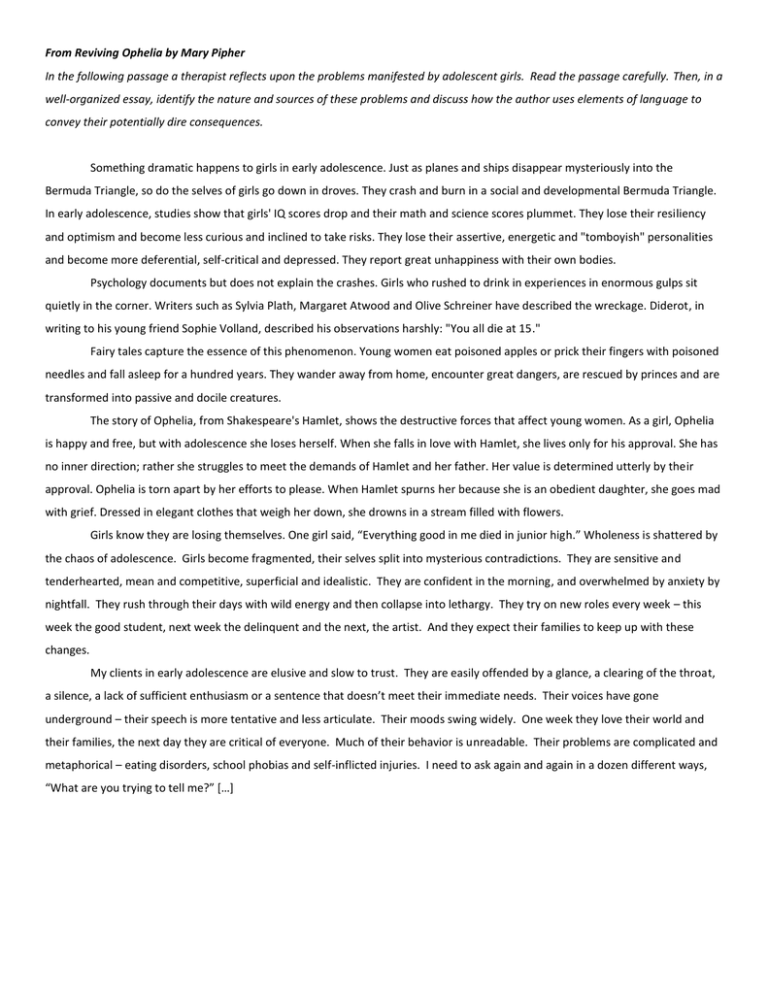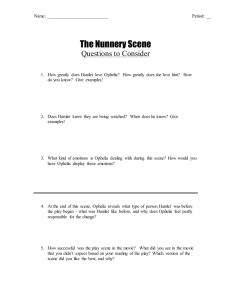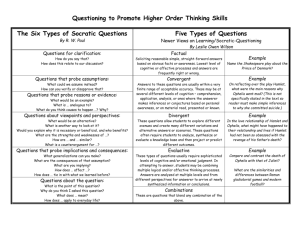From Reviving Ophelia by Mary Pipher In the following passage a
advertisement

From Reviving Ophelia by Mary Pipher In the following passage a therapist reflects upon the problems manifested by adolescent girls. Read the passage carefully. Then, in a well-organized essay, identify the nature and sources of these problems and discuss how the author uses elements of language to convey their potentially dire consequences. Something dramatic happens to girls in early adolescence. Just as planes and ships disappear mysteriously into the Bermuda Triangle, so do the selves of girls go down in droves. They crash and burn in a social and developmental Bermuda Triangle. In early adolescence, studies show that girls' IQ scores drop and their math and science scores plummet. They lose their resiliency and optimism and become less curious and inclined to take risks. They lose their assertive, energetic and "tomboyish" personalities and become more deferential, self-critical and depressed. They report great unhappiness with their own bodies. Psychology documents but does not explain the crashes. Girls who rushed to drink in experiences in enormous gulps sit quietly in the corner. Writers such as Sylvia Plath, Margaret Atwood and Olive Schreiner have described the wreckage. Diderot, in writing to his young friend Sophie Volland, described his observations harshly: "You all die at 15." Fairy tales capture the essence of this phenomenon. Young women eat poisoned apples or prick their fingers with poisoned needles and fall asleep for a hundred years. They wander away from home, encounter great dangers, are rescued by princes and are transformed into passive and docile creatures. The story of Ophelia, from Shakespeare's Hamlet, shows the destructive forces that affect young women. As a girl, Ophelia is happy and free, but with adolescence she loses herself. When she falls in love with Hamlet, she lives only for his approval. She has no inner direction; rather she struggles to meet the demands of Hamlet and her father. Her value is determined utterly by their approval. Ophelia is torn apart by her efforts to please. When Hamlet spurns her because she is an obedient daughter, she goes mad with grief. Dressed in elegant clothes that weigh her down, she drowns in a stream filled with flowers. Girls know they are losing themselves. One girl said, “Everything good in me died in junior high.” Wholeness is shattered by the chaos of adolescence. Girls become fragmented, their selves split into mysterious contradictions. They are sensitive and tenderhearted, mean and competitive, superficial and idealistic. They are confident in the morning, and overwhelmed by anxiety by nightfall. They rush through their days with wild energy and then collapse into lethargy. They try on new roles every week – this week the good student, next week the delinquent and the next, the artist. And they expect their families to keep up with these changes. My clients in early adolescence are elusive and slow to trust. They are easily offended by a glance, a clearing of the throat, a silence, a lack of sufficient enthusiasm or a sentence that doesn’t meet their immediate needs. Their voices have gone underground – their speech is more tentative and less articulate. Their moods swing widely. One week they love their world and their families, the next day they are critical of everyone. Much of their behavior is unreadable. Their problems are complicated and metaphorical – eating disorders, school phobias and self-inflicted injuries. I need to ask again and again in a dozen different ways, “What are you trying to tell me?” […]






